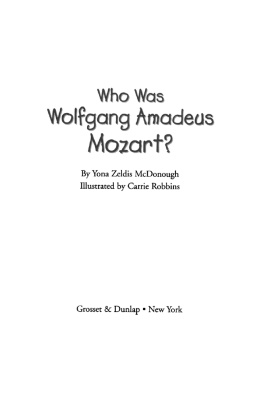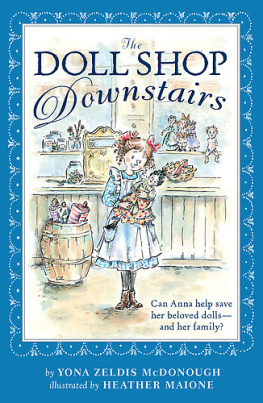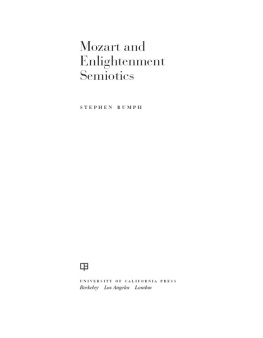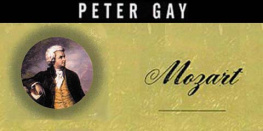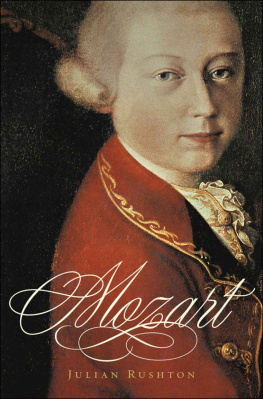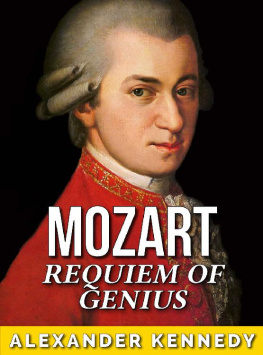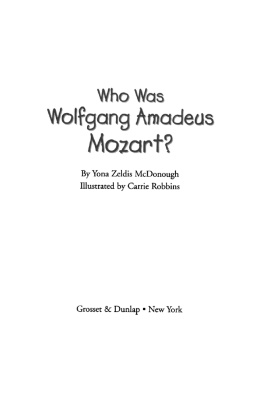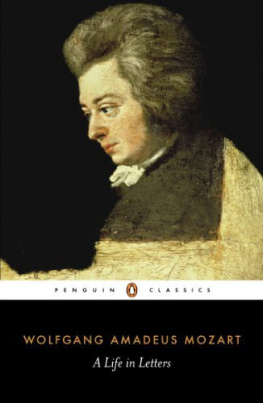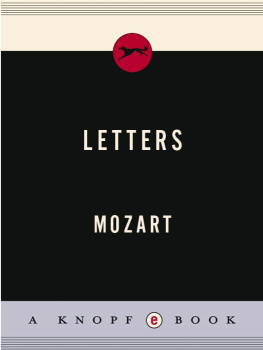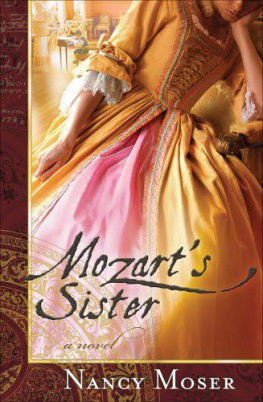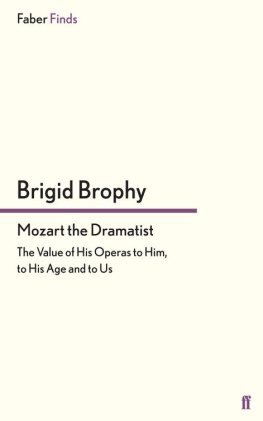Who Was Wolfgang Amadeus Mozart?

Who Was Wolfgang Amadeus Mozart?
By Yona Zeldis McDonough
Illustrated by Carrie Robbins
Grosset & Dunlap New York
For my children, James and Katherine
McDonoughY.Z.M.
To Richard, who may not have the chance to see the finished book, but whose spirit is in every picture. With love alwaysC.R.
Text copyright 2003 by Yona Zeldis McDonough. Illustrations copyright 2003 by Carrie Robbins. Cover illustration copyright 2003 by Nancy Harrison. All rights reserved. Published by Grosset & Dunlap, a division of Penguin Putnam Books for Young Readers, 345 Hudson Street, New York, NY 10014. GROSSET & DUNLAP is a trademark of Penguin Putnam Inc. Published simultaneously in Canada. Printed in the U.S.A.
Library of Congress Cataloging-in-Publication Data
McDonough, Yona Zeldis.
Who was Wolfgang Amadeus Mozart? / by Yona Zeldis McDonough;
illustrated by Carrie Robbins.
p. cm.
Summary: Explores the life and work of the prolific eighteenth-century
Austrian composer who began life as a child prodigy, composing music at
the age of five, and died a pauper at age thirty-five.
1. Mozart, Wolfgang Amadeus, 1756-1791Juvenile literature.
2. ComposersAustriaBiographyJuvenile literature. [1. Mozart, Wolfgang
Amadeus, 1756-1791. 2. Composers.] I. Title.
ML3930.M9 M21 2003
780.92-dc21
2002151261
ISBN: 978-1-101-64002-9 20 19 18 17
Who Was Wolfgang Amadeus Mozart?
More than 200 years ago, there was a little boy who learned to play a musical instrument at the age of three. It was called a clavier, which was an old-fashioned stringed instrument that also had a keyboard. By the time he was five, he was composing beautiful musicall by himself. At eight, he had learned to play two more instruments, the violin and the organ. Now he could play three instruments.


His father was a musician, too. He wanted everyone to pay attention to his talented son. But some people had a hard time believing that a small boy could be so talented. They thought his father had written the music for him. Or that the boy wasnt a child at all, but a very small adult. There had to be some kind of trick.

A man who was both a lawyer and a musician decided to find out. He tested the boy for many hours. He asked the boy to play a very difficult piece of music. The boy played it easily and well. Then he asked the boy to make up a piece of music for him, right there on the spot. Again, the boy did an excellent job.
Then, a cat came into the room. Right away, the boy stopped playing music and got up to chase it. There was no doubt in the mans mind. The boy was really just a boy, except when he played or wrote music. Then the boy was a genius.
Who was this boy? His name was Wolfgang Amadeus Mozart, and here is his story.

Chapter 1
Little Boy, Big Talent
Papa Leopold Mozart was very strict. He was a composer and violinist in Salzburg in Austria. When he was finished working for the day, Leopold came home and gave his daughter and son music lessons. Over and over they played what he taught them. They spent hours every day practicing. Both children became really good musicians. But the boy, Wolfgang, was even more talented than his sister.

Wolfgang was born on January 27, 1756, in Salzburg, Austria. (On the map, the little star inside the Austrian monarchy shows where Salzburg is.) Six children had come before him, so he was the baby of the family. But only Wolfgang and his big sister, Maria Anna, lived past their first birthdays. Back then, when babies or young children got sick, there were no medicines like there are today. So, sadly, it was common for children to die.


Because Wolfgang had such a long name, his family called him Wolferl, or sometimes Wolfie, for short. Maria Anna was called Nannerl. And the family dog was called Bumperl.
When Nannerl was seven, Papa Leopold started teaching her how to play the clavier. Wolfie, who was only three, could not keep away from the lessons. He would sit on the floor, listening to the music while she played. But Wolfie was not satisfied. He wanted more: He wanted to play, too. After Nannerls lesson was over, he went up to the clavier. He was so small that he had to stand on his toes to reach the keys. He tried one note and then another. He liked the sounds that came out of the clavier. They made him smile. But when he played two notes he didnt like, it made his ears hurt. Hed become so upset that hed cry. Even as a tiny child, Wolfie knew which notes sounded right together and which notes did not.
Papa Leopold started giving Wolfie lessons, too. Soon Wolfie could play all the tunes in Nannerls music notebook.

Keyboard Insturments in the 18th Century

Harpsichord
The harpsichord was the most popular of the early keyboard instruments. The strings were made of metal and plucked with quills. The metallic sound was not pleasing to musicians ears, but Mozart figured out a way to make music sound more beautiful on the harpsichord.
Clavichord
The clavichord was basically a simpler and smaller version of harpsichord that people played at home.
Fortepiano
The name means loud-soft. Its strings are struck by a covered hammer so the sound can be loud or soft. The fortepiano sounded much more pleasing to musicians and composers than the harpsichord. It also was the first instrument with levers that were worked by the feet. This, too, produced a richer sound.


Spinet
The spinet was a tabletop version of the harpsichord with fewer octaves and the same quality of sound.

Organ
The organ usually has two keyboards and pedals which play extra notes. Most music written for the organ is for church services. The huge sound is produced by air moving through pipes of different lengths.
Next page
